Ljubljana related
Here’s a fascinating documentary, in Slovenian with good English subtitles, that takes you into the world of the kurenti. It shows some of the history, present and enduring magic and mystery of these hairy figures, who with bells and whips will help scare the winter away over the next few days around Slovenia, as part of the Pust / Shrovetide celebrations.
And here's another short film on the same subject, from UNESCO
Many places are celebrating Pust this Saturday (22/02), with the Shrovetide/pagan carnival giving people an excuse to dress up and take part in, or watch and thus enhance, a variety of ethnographic spectacles and traditions. Not least of these will be the parades featuring characters such as the UNESCO recognised kurenti – the hairy guys with bells – along with witches, idiots, whip-crackers and more, as seen in the following photographs and which you can read more about here.

Wherever you are in Slovenia you shouldn't be too far somewhere doing something like this, if not on Saturday then in the days after, and if you're lucky enough to be around some of the bigger celebrations then it's a good idea to make sure your phone and / or camera battery is fully charged. I took the pictures shown above at last year’s Dragon Parade in Ljubljana, to be held again this Saturday, starting at 11:00 in Prešeren Square, but also making its way through the streets to end up with an entertainment programme in Kongresni trg / Zvezda Park.
February 8 is Prešeren Day, when Slovenia marks the death of its national poet - France Prešeren (1800 – 1849) - and more broadly its cultural heritage, along with that of the wider world. As such all state and municipal museums and galleries will give free entry, and various other cultural programmes will be on offer. If there’s a cultural institution you’ve been meaning to visit a long time then this is the day to make plans for. Go online and check out the galleries and museums that share your interests and then see how much culture you can absorb in one day.
On a national scale, perhaps the main event is in Kranj, where the poet died at the age of just 48. Prešeren Fair takes you back to the days of 19th century Romanticism. You can expect people in costumes, traditional crafts, poetry, dancing and music, plus the usual open doors and guided tours of museums and galleries. The occasion also sees the “ Gathering of the muses on the Carniolan Parnassus”, which draws some of the artists and writers who have won the Prešeren Award or Prešeren Fund Award, and makes them available to the public. The day starts at 10:00 with the Kranska kuhna street food event, open till 18:00, although the official opening of the fair is at 11:00 in front of the Prešeren Theatre. The full programme can be found here.
If you’re in Ljubljana then there are plenty of options, from recitals of Prešeren’s work in front of the Prešeren Monument in Prešeren Square, to all the public museums and galleries the city hosts. Good places to focus are the Metelkova Museum Quarter, home to the branch of the Modern Gallery that covers contemporary art, the Ethnographic Museum and a branch of the National Museum. On the other side of town, but still not far away, you could focus on the National Gallery and the main branches of the Modern Gallery and National Museum.
Note: not all of the museums and galleries market are public ones. For example, Union's "beer museum" will not be free to enter
There’s also the chance to see inside the Presidential Palace (Erjavčeva cesta 17), with two events on Saturday. One at 11:00 is limited to the first 100 people who start gathering in front of the Palace at least 30 minutes beforehand. Those allowed inside will hear a speech from President Borut Pahor, enjoy some music, and get a tour of the building. Less exclusive tours will also be on offer between 13:00 and 15:00, with no limits on the numbers given by the President’s Office – just turn up and wait at the entrance.
Overall, if you’re in Slovenia on 8 February then you’re in luck with regard to culture. On the downside, it's a national holiday, and thus many supermarkets and other stores are likely to be closed. As such please remember to get your coffee, milk, bread, wine and other essentials on Friday, unless you plan on eating out or know an always open convenience store.
STA, 10 December 2019 - A Ljubljana stadium designed by acclaimed architect Jože Plečnik in the 1920s has been shortlisted as one of the 14 pieces of European cultural heritage that could be put on a list of seven most endangered pieces.
The 7 Most Endangered pieces of European heritage will be declared in March 2020, the European Commission Representation in Slovenia said in a release on Tuesday.
The stadium was nominated for protection within a campaign of the pan-European Europa Nostra organisation and the European Investment Bank Institute by the Ljubljana Association of Architects.
The association would like to protect this masterpiece of Plečnik's, which has been been decaying for a decade, so that it could be used again in its original form.
Related: Shameful Condition of Plečnik's Stadium in Ljubljana: An Example of Poor Governance?
The landmark stadium began to be built in 1925 for a Catholic sports association as one of the first such facilities in Europe.
In 2003, Slovenian rock band Siddharta filled it with 30,000 fans for a memorable concert, while Depeche Mode played there in 2006.
One of the most notorious events associated with it is the oath the Slovenian pro-Nazi militia Domobranci swore to Adolf Hitler in 1944.
The Bežigrad stadium, as it is sometimes referred to, was used for sport events and concerts until 2007, while efforts to renovate it have turned into a saga.
At the time, entrepreneur Joc Pečečnik's GSA company entered a partnership with the city of Ljubljana and the Slovenian Olympic Committee to renovate it.
Their company BŠP closed the stadium in January 2008, while in 2009 the Berlin-based GMP studio was selected in a public tender to renovate it.
But since then, a combination of problems surrounding the environmental permit, locals complaining about a piece of land between the stadium and their blocks of flats, and a civil initiative insisting the stadium be preserved in its original form has pushed the project into a limbo.
The 7 Most Endangered programme was launched in January 2013 as a civil society campaign to protect European heritage, although it brings no direct funding.
It identifies the most threatened monuments, sites and landscapes in Europe and mobilises public and private partners to find viable solutions.
All our stories on Plečnik are here, while those on architecture are here
If you’re in the euro zone and have some coins then there’s a chance you’ve got some icons of Slovenia in your pocket. This is because the EU allows countries to choose their own designs for the reverse sides of coins, and back in 2004 and 2005 Slovenia chose eight, one for each denomination. (Although if this comes up on quiz night, note that the country didn’t start using the currency until 1 January 2007.)
Each design represents something from Slovenian culture, which we’ll present below should you decide to take an interest in numismatics and want to collect the whole set, or find yourself left to your own devices, without a phone, friend or book, and only a pocketful of change for entertainment.
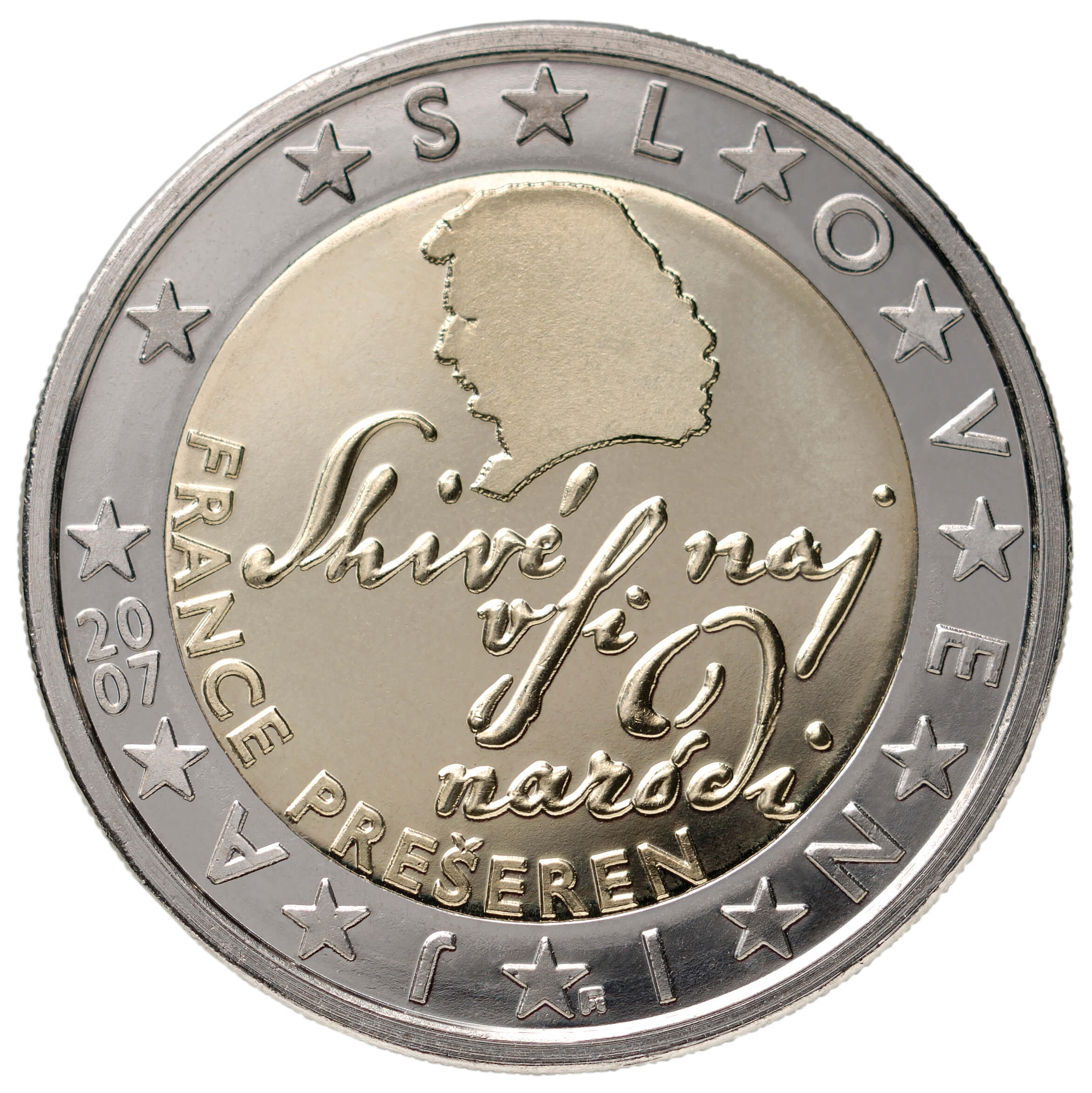
France Prešeren, the 19th century poet, appears on the two euro coin, as befits the man whose words would go on to become the Slovenian national anthem. Since there’s no attested authentic portrait of the man, despite the images of him you’ll often see, and the statue that stands in his namesake square in Ljubljana, his face is only shown in silhouette. However, the first line of the poem that’s used in the Slovenian anthem is shown in his handwriting: Žive naj vsi narodi (May all nations live).

Primož Trubar (1508 – 1586) is the other literary figure shown on Slovenian coinage, the author of the first two books printed in the Slovene language, Catechismus and Abecedarium, a religious work and one to help people learn the alphabet, respectively. Along with the man’s portrait the coin bears the words Stati inu Obstati (To exist and persevere).
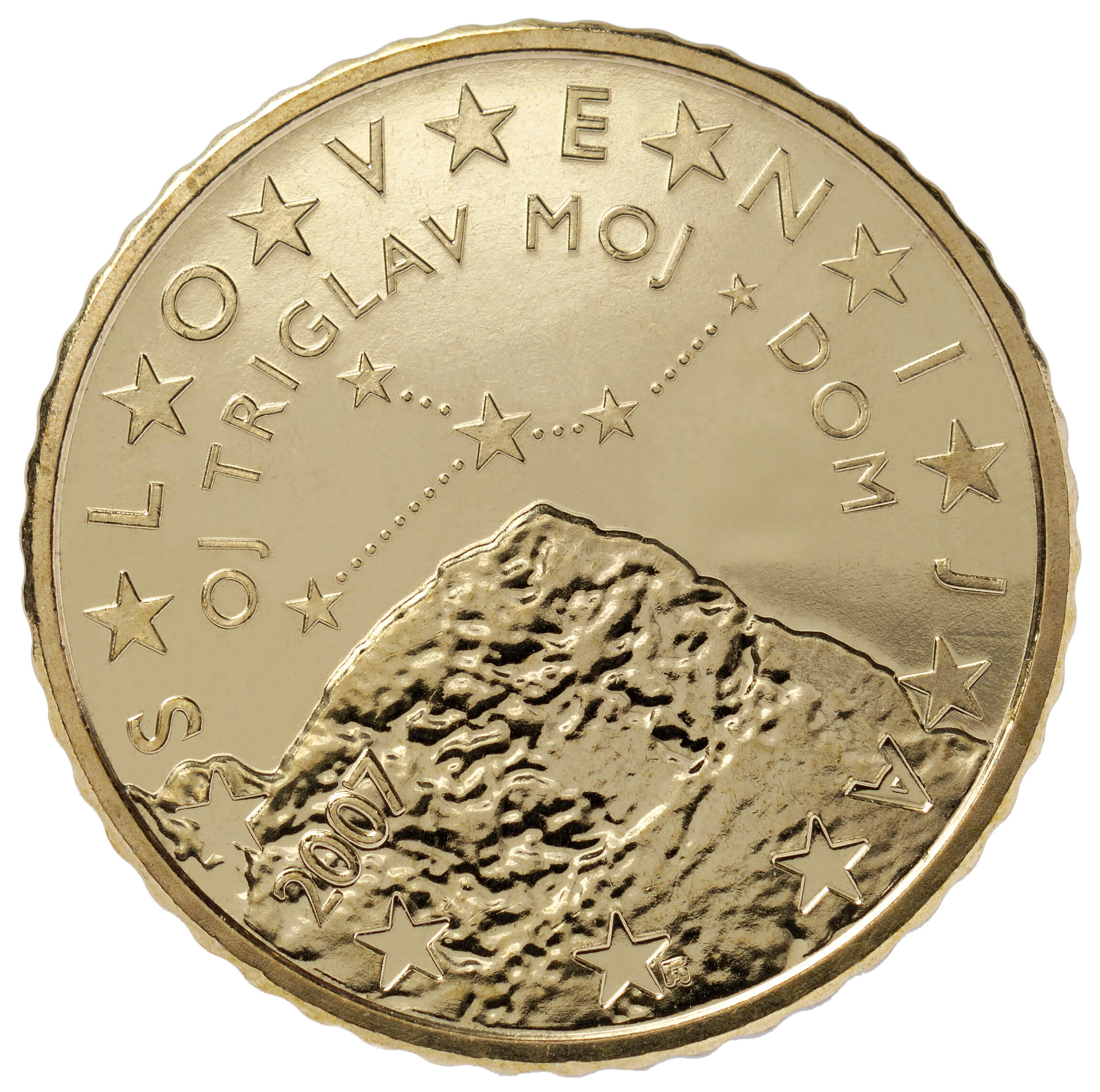
Triglav is the tallest mountain in Slovenia, and “all true Slovenes” are supposed to climb it at least once in their lives. The triple peak, which is easier to see in stylized representations that real life, was used as a symbol by those fighting against occupation in World War 2 and can be seen on the Slovenian flag. Also shown on the coin, above the peak, is the constellation of Cancer, the sign of zodiac under which the nation finally achieved independence, on 23 December 1990. The inscription reads Oj Triglav moj dom (Oh Triglav, My Home).
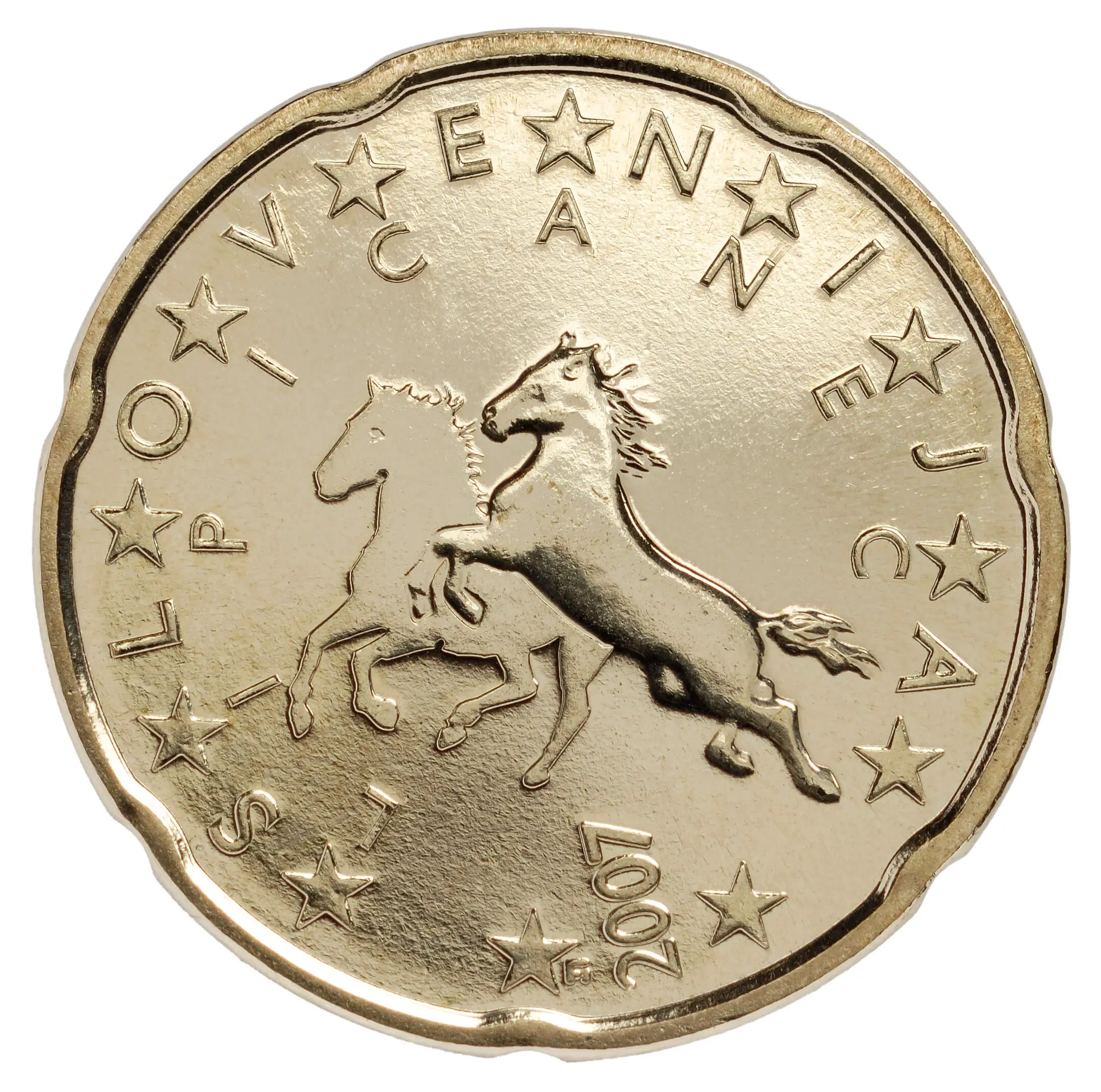
While Austria makes a claim to Lipizzaner horses, because they served the imperial court under the Austro-Hungarian Empire, they were (and are) bred and trained in Lipica. The 20-cent coin shows two of them at play. The inscription says Lipicanec, or Lipizzaner.
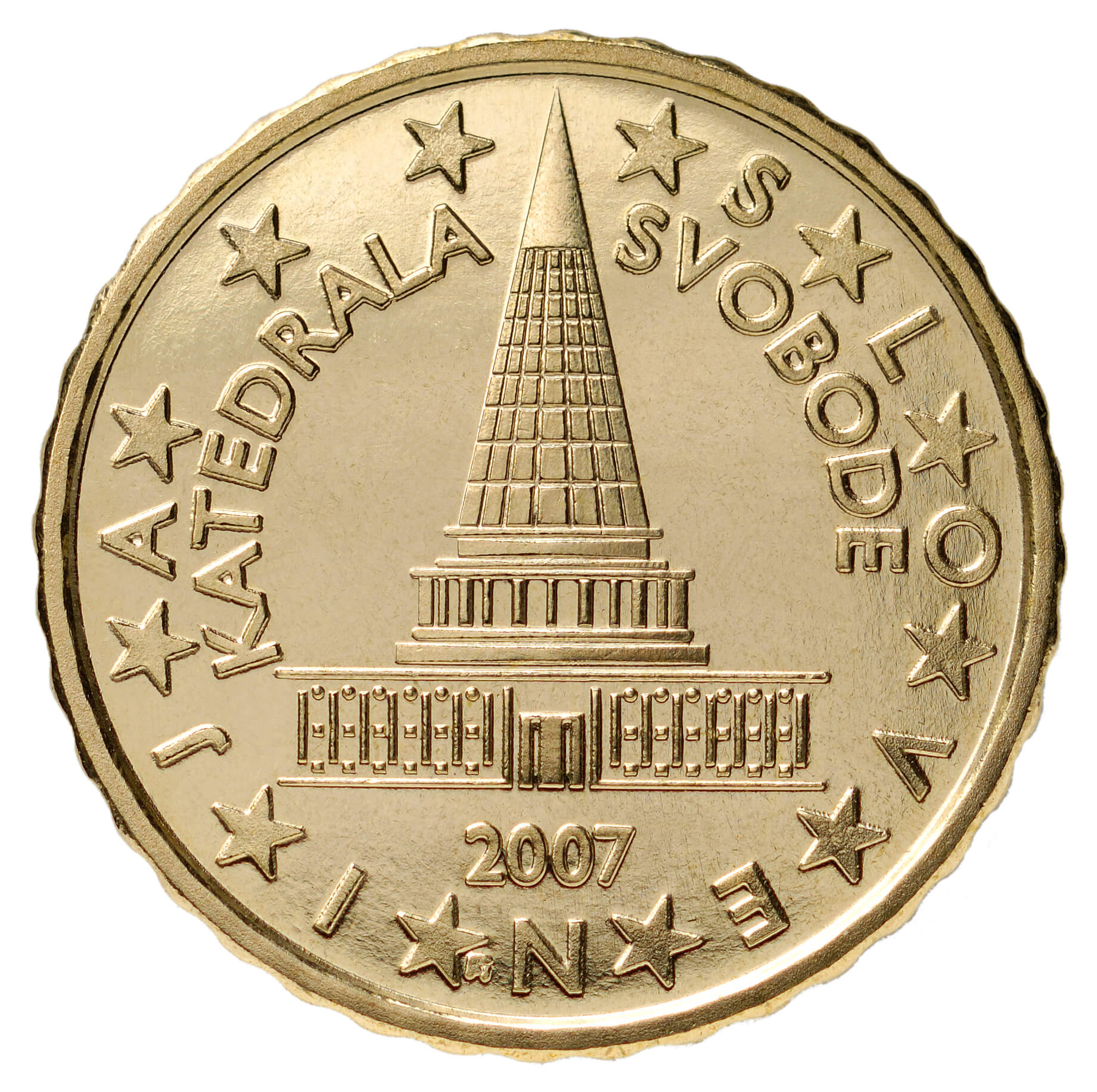
Jože Plečnik is the architect mostly closely associated with Ljubljana, responsible for the Triple Bridge, Križanke, the Central Market, the Arcades, the National University Library and more (although not Dragon Bridge). The 10-cent coin shows one of his many unrealised and perhaps overambitious works – a structure formally known as the Slovene Acropolis or Cathedral of Freedom (Slovenska akropola / Katedrala svobode), with that latter name appearing along with the image. You can see more of Plečnik’s unrealised works for the city here.
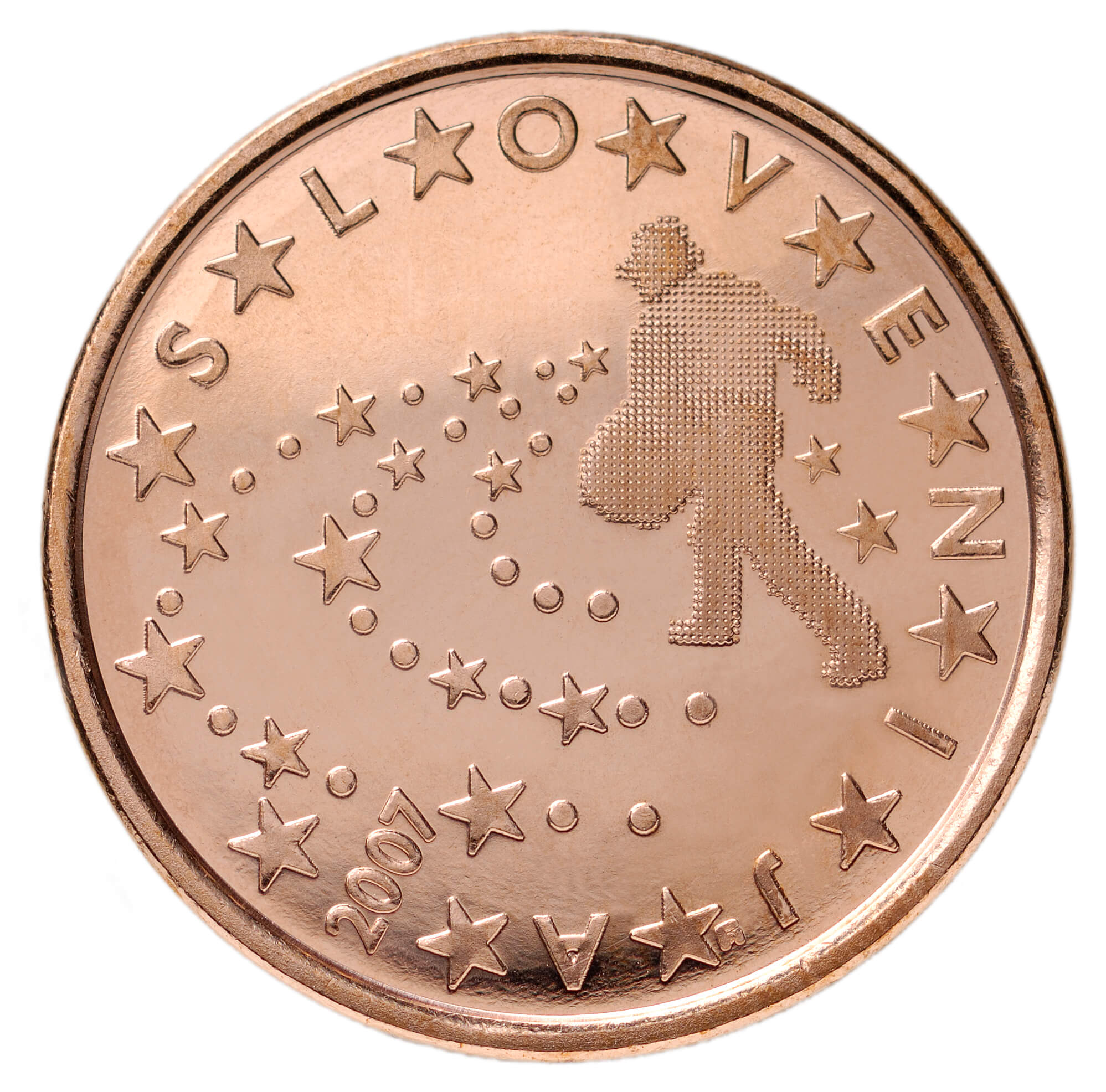
The five-cent coin shows a man sowing seeds in a field, which – according to the Bank of Slovenia – represents the moment when a farmer is closest to God. The design is based on a famous painting called The Sower (Sejalec) by the Slovene impressionist Ivan Grohar, with can be found in the National Gallery.
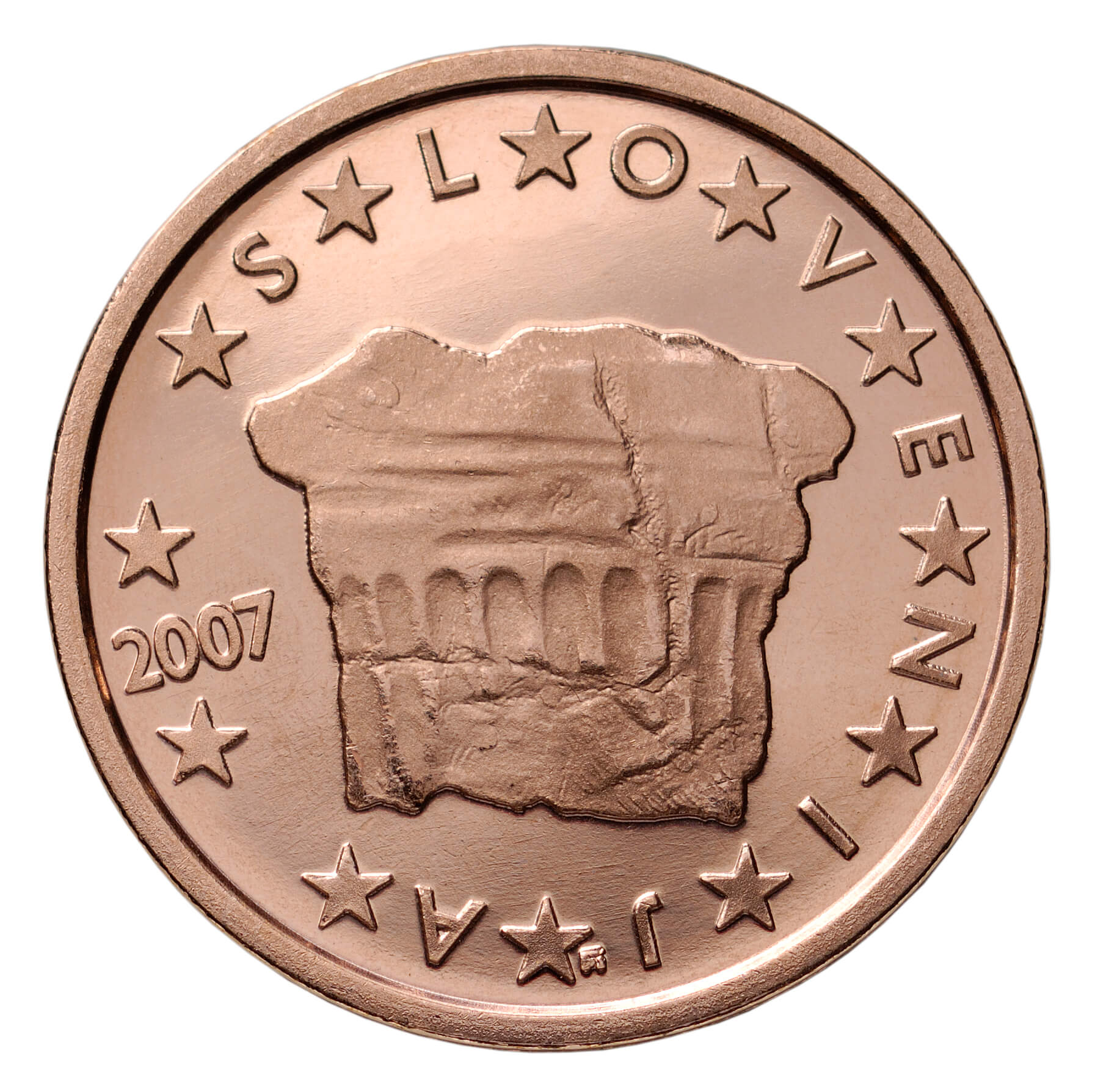
This unassuming looking stump is in fact “the Prince’s Stone” (knežji kamen), the reversed base of an ancient Ionic column, thought to be from the Roman city of Claudium Virunum (today’s Zollfeld, Austria), which was used in the ceremony for the coronation of the Dukes of Carinthia.
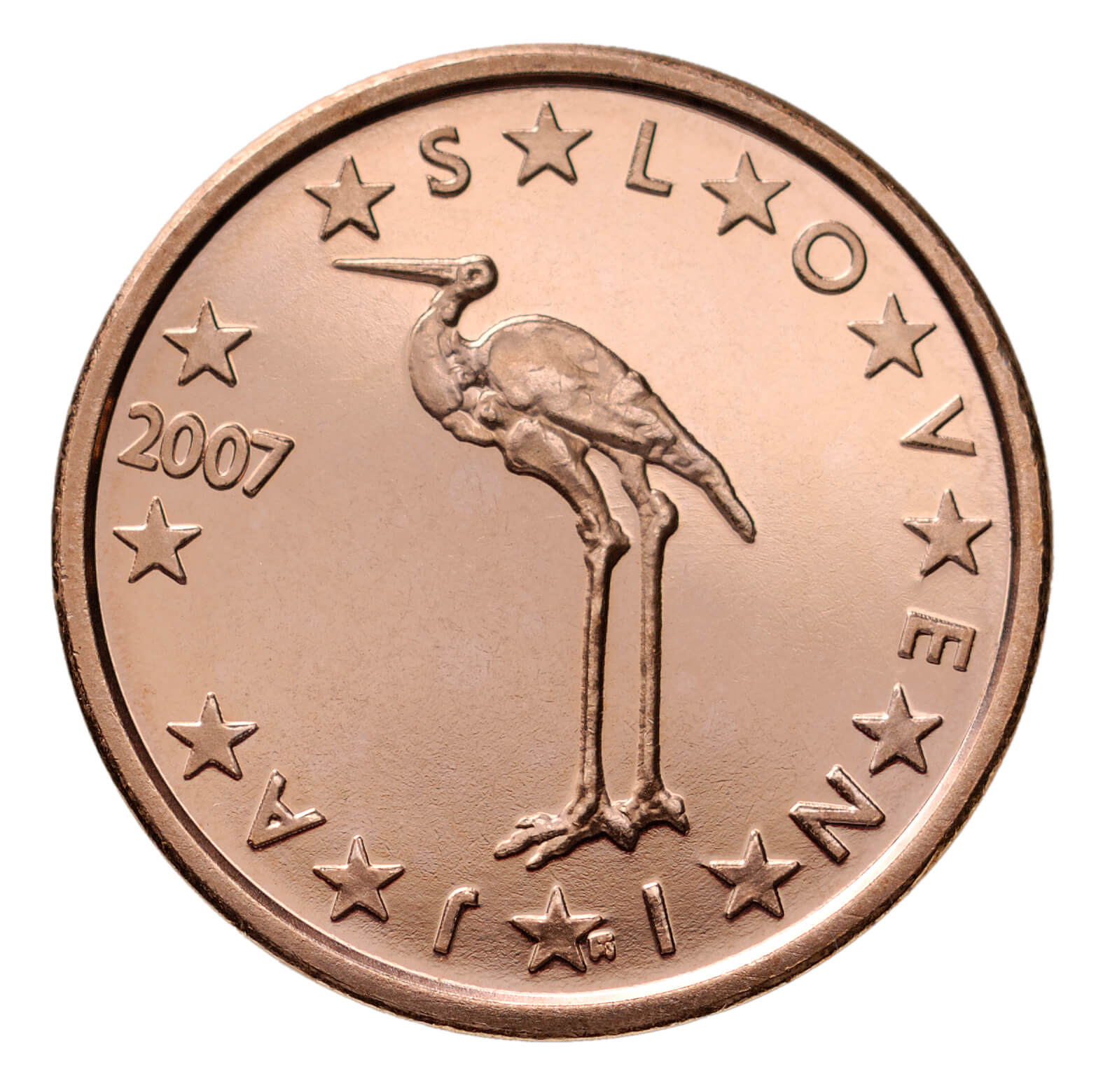
The stork shown on the humble one-cent coin is a vestige of Slovenia’s pre-euro currency, the tolar, which lasted from 8 October 1991 to 1 January 2007. This motif originally appeared on the 20 tolar coin.
Related: A brief history of money in Slovenia
STA, 3 December 2019 - More than 300 events in galleries, museums, theatres and other cultural organisations around the country will be available free of charge for all age groups on Tuesday, 3 December, in memory of the birthday of Romantic poet France Prešeren (1800-1849).
The Merry Day of Culture, as the campaign is termed, is organised for the 20th year in a row, bringing exhibitions, theatrical shows, guided tours, workshops etc.
The campaign has been designed to reach out to those who rarely visit cultural organisations and events.
It has become very popular, and many museums and galleries have traditionally been the busiest venues on 3 December.
In Ljubljana, permanent and temporary exhibitions at all national museums and galleries will open the door to the public free of charge.
A number of events will be organised at Ljubljana Castle, the National and University Library, Cankarjev Dom and the Theatre Museum.
Novelties in the Fran web portal which features several dozen dictionaries and Slovenian language resources will also be presented to the public.
Given that 3 December falls on a weekday this year, groups organised by schools are expected to dominate among the visitors.
STA, 13 September 2019 - Ljubljana and a total of 25 surrounding municipalities have signed an agreement to cooperate in the bid of the Slovenian capital to be awarded the title of the European Capital of Culture (ECC) in 2025. They are joining Lendava, Nova Gorica, Ptuj, Kranj and Piran as the candidate cities.
The agreement was signed in Ljubljana on Friday by mayors and representatives of the 26 municipalities, which comprise the Ljubljana Urban Region, followed by the opening of the ECC information office in Stritarjeva Street.
Nina Peče Grilc, who heads the team preparing the bid, announced an ambitious programme with which Ljubljana and the partner municipalities "will respond to challenges of the future and increase the quality of live in the region."
According to her, the bid is an opportunity for all potential hosts to strengthen the role of culture in their development plans, and create a new regional cultural identity by connecting artists and building a new audience.
Peče Grilc said that a successful ECC project would have a positive effect on the entire region, both in culture and in related fields, such as tourism, education, healthcare, social cohesiveness, creative industries and environmental protection.
A public call for the submission of programme concepts will be published next week, she said, adding that the agreement contained a number of commitments, including that at least a third of events take place outside the Ljubljana municipality.
Lilijana Madjar, the director of the regional development agency, said that the ECC was a "flattering title, an excellent brand and a great commitment".
Mateja Demšič of the culture department at the Ljubljana municipality added she was happy that culture had become another binding agent among the participating municipalities, noting that the region was already connected through many projects.
Ljubljana Mayor Zoran Janković expressed the wish that culture projects reach beyond the region, and announced that in Ljubljana, which annually hosts 14,000 cultural events, their number would increase further with the ECC title.
Slovenia has been selected to get the ECC title in 2025 along with Germany, with the other potential candidate cities being Kranj, Ptuj, Lendava, Piran and Nova Gorica, some of them with partner cities.
Slovenia's second largest city Maribor held the title in 2012 together with Portugal's Guimaräes.
The second week of September brings a long-standing tradition to Kamnik, along with some 30,000 visitors, as the Days of National Costumes and Clothing Heritage (Dnevi narodnih noš in oblačilne dediščine) returns for its 47th edition, offering a full programme of ethnological, cultural and entertainment events all through the day and into the evening.
Named by the UK’s Guardian newspaper as among the top 20 traditional festivals in Europe, the focal event is always the parade of traditional national costumes, which this year takes place at 15:00 on Sunday, 8 September. This year the traditional Slovenian costumes will be joined by those from Bosnia and Herzegovina, Belarus, Turkey, Kosovo, Bulgaria and Austria, giving added interest to an already colourful event.
Beyond the parade there’s much for those interested in clothing, history, cultural heritage, music and more to enjoy, with exhibitions at various locations around town along with a traditional art and craft fair and demonstrations in the medieval part of town (5 – 8 September), folk dance and music on in Glavni trg (Saturday and Sunday), workshops for children, street music and an evening entertainment programme that includes live performances from Ansambel Domačini, Skupina Harmonk’n’roll, Skupina Špica, Obvezna smer, Manouche, and Andrej Šifrer, with videos below for your education and entertainment.
The full details are here and you’ll find that it’s a packed and varied festival – a great excuse to (re)visit the many charms of Kamnik and learn more about Slovenia.
STA, 21 July 2019 - The Culture Ministry has recently added a number of activities or characteristics in the Slovenian intangible cultural heritage register, including building and rowing Pletna boats on Lake Bled, mobile beekeeping and the Prekmurje dialect.
Building and handling Pletna boats is a skill passed on from one generation to another and an established local tradition popular among visitors of the Bled lakeside resort.
The Bled island was a pilgrimage site already in the 12th century, with locals setting up piers and transporting people to the island. Even back then, they used boats they built themselves.
In the 18th century Habsburg dominions ruler Maria Theresa granted local farmers the rights to perform lake transports as a source of some extra money.
This typical Bled activity has stayed alive until today due to the development of tourism, with the shape of the Pletna boat changing over time.
The current form was designed by the locals at the turn of the 19th century, based on similar boats which were used on central European lakes.
After the First World War, an awning was added to the boat to shelter visitors from the sun and rain.
The Pletna boat used to be shorter but today the 8-metre vessel can transport up to 18 passengers. The boat's skipper or Pletnar rows and steers the boat with two oars, whose length amounts to 3 metre, while standing.
Only a few master craftsmen from Bled are still building Pletna boats, with every one of these vessels being an original. The lifespan for the boats is up to 50 years if they are being regularly maintained.
According to the Culture Ministry, the Pletna transport is key for preserving the local environment and the fragile Lake Bled ecosystem.
Apart from that, building and handling those boats have become the local community's trademark and part of its identity.
According to the head of the Pletna Bled boating association Gregor Pazlar, there are currently 23 Pletna skippers. They were the ones who initiated the process of entering the local tradition in the intangible cultural heritage register.
"The Pletna activities and skill are something special, since those boats are representative of Lake Bled. It's an activity that can be found only here," said Pazlar. Four years ago Pletna skippers already registered the Pletna trademark and name.
The Slovenian intangible cultural heritage register currently includes 72 units and 200 intangible cultural heritage holders.
Apart from the skill of building and rowing Pletna boats, another addition is mobile beekeeping, which stands for transporting bees in their hives to make a better use of bee pasture.
Yet another, addition, the Prekmurje dialect is part of the Pannonian dialect group, consisting of three subdialects - the Goričko, Ravensko and Dolinsko ones.
Until the standardisation of the Slovenian literary norm in the 19th century, the Prekmurje dialect used to be a regional literary variant of Slovenian.
It’s the time of the Ice Saints, and in Slovenia this year Ledeni Možje have brought with them the coldest period in May for 15 years, and as I sit here now writing this, Polulana Zofka is truly pissing herself.
Confused? Let me explain.

Rain clouds clearing over the Kamnik Alps after a day of heavy rain last week. On the higher ground they brought snow.
The Ice Saints
Ledeni Možje (the Ice Men) is a legend in Slovenia that derives from a wider legend throughout much of Europe, the legend of the Ice Saints. The three Ice Saints are Saint Boniface, Saint Pancras, and Saint Servatius. Their feast days are celebrated on May 11th, 12th and 13 across much of Southern Europe. In Slovenia however, the days are 12th, 13th and 14th. During this period in Central Europe it’s often believed there is a sharp drop in temperature. Farmers in many European countries will not plant their crops until after this period has passed; chiefly because it can also bring a late frost.
Pissing Sophia

Rain over Lake Bohinj, Triglav National Park, Slovenia.
Today, May 15th, is the feast day of Saint Sophia of Rome, known here in Slovenia as Mokra Zofka (Wet Sophia) or under the more comical name of Polulana Zofka (Pissing Sophia). Traditionally on Saint Sophia’s Day it rains a lot.

In Slovenia it’s easy to be confused about the weather this time of year. It can be sunny one minute, and rainy the next. Best to be prepared as this man with the umbrella was in Kongresni Square, Ljubljana, Slovenia.
So, in Slovenian Folklore if the Ice Men bring the cold weather, and Sophia pisses herself, then the belief is that this heralds a very hot and sunny summer.
Well over the last few days the temperatures have plummeted to mark the coldest May for 15 years. A couple of weeks ago it was over 20 degrees and sunny. Today it is 6 degrees and truly pissing down with rain. So if the legend is true, we are in for a very hot summer indeed.
As a Slovene who is used to hot summers, my wife is very happy about this. But as a wimpy Englishman who hates the heat and, as a landscape photographer who also hates hot, clear sunny days because clear skies are boring and heat produces humidity which reduces clarity, I feel a sense of foreboding.
Time to invest in that air conditioning unit, and a photography trip to cooler climates!



























